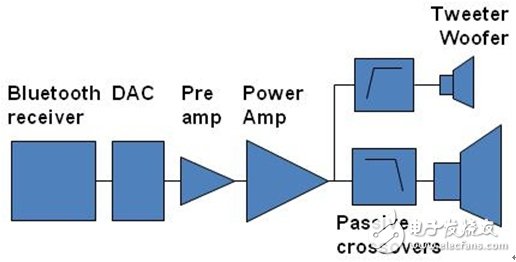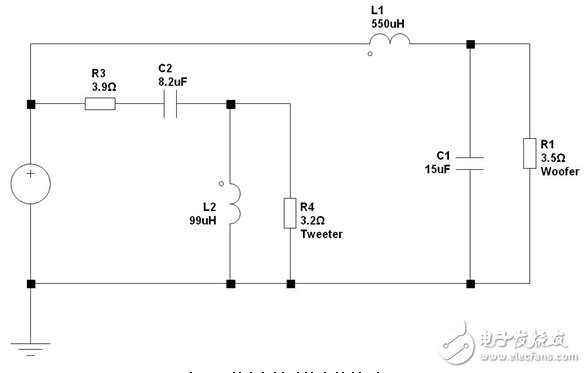What's the lack of you in the hot download of the "Video and Audio Technology Special Issue" in November by the electronic enthusiast website!
Consumers want fewer cables to connect their home entertainment systems, and the better, so there is a demand for wireless active speakers. In order to provide the best audio quality through high-end active speakers, we can use a variety of technologies to improve their performance; in this case, digital active crossovers can play an important role.
Current wireless active speakers have four components in the signal path before the driving device, namely: receiver, DAC, amplifier and frequency divider. The receiver can be a Bluetooth device that runs a high-efficiency codec; the amplifier may be a conventional analog input class AB device, and the high-efficiency DAC through its input port guarantees high audio quality; and the last component on the signal path is passive Crossover network.
Alternatively, we can also use high-efficiency Class D amplifiers to directly drive high and low speakers by increasing efficiency. If the class D amplifier has a digital input port, you can use DSP resources to implement an efficient digital divider. Compared with passive dividers, digital dividers have great advantages.
Active speaker architecture
Figure 1 shows a conventional wireless active speaker architecture. The receiver is a Bluetooth device, which can run efficient codecs such as aptXTM to ensure the best audio performance. In order to facilitate the conversion from the digital domain to the analog domain, the system needs to configure an efficient DAC before the amplifier input port. The preamplifier and power amplifier operate in the analog domain, and a single power amplifier simultaneously drives the high and low speakers.

Figure 1: Conventional wireless active speaker architecture
Providing higher audio quality requires a class AB amplifier architecture. However, analog input Class D amplifiers are very power-saving, which is very attractive; today's closed-loop analog input Class D amplifiers can also provide good audio performance. Increasing efficiency also means saving power.
In this architecture, the passive crossover network provides high-pass and low-pass filtering to decompose the audio signal into the appropriate frequency band for the high and low drivers.
The emergence of ultra-efficient digital input Class D amplifiers makes another architecture also very attractive, see Figure 2. In this architecture, the audio signal stays in the digital domain before the output of the amplifier power stage, which is an audio performance advantage in itself-no DAC digital-analog conversion is required, eliminating conversion errors.

Figure 2: Wireless active speakers using digital input Class D technology
In order to achieve the best audio performance, a closed-loop digital amplifier needs to be selected. The platform in this example is CSR Direct Digital Feedback Amplifier (DDFATM) technology.
Under this architecture, the functions of the preamplifier and power amplifier are realized by a single circuit. Although each driver requires an amplifier channel, the power level of each channel can be precisely adjusted according to high and low sensitivity.
In terms of crossovers, the available signal processing capabilities can achieve great advantages. The on-chip DSP makes it easy to implement efficient filters. The filters are configured to fully match the driver characteristics, so no passive components are required.
Passive crossover and active crossover
Figure 3 shows the implementation of a typical passive crossover. This example will be discussed in more detail below.

Figure 3: Implementation of passive crossover
This design uses a conventional second-order filter for each driver, and the crossover frequency is approximately 2.2 kHz. The bass impedance is 3.5Ω and the treble impedance is 3.2Ω.
The circuit consists of simple inductors and capacitors. Because they are on the power path, the inductors and capacitors must be relatively large. However, this may result in loss of efficiency, leading to heat dissipation and performance shifts. As the power level increases, these effects will deteriorate further, eventually leading to a higher degree of distortion.
Although the circuit design seems simple, the interaction of the components is very complicated, so it is difficult to completely isolate each driver. The characteristics of the driver change with changes in frequency, power and temperature, and the response of the filter is directly affected by this.
The frequency divider adds filler resistors to match various driver sensitivities, which leads to a further increase in heat dissipation. Therefore, it must be implemented correctly, otherwise the over-powered inductors will saturate, causing distortion at high power, and even fail to destroy the tweeter.
Electric Ceramic Cooktop,Ceramic Surface Cooktop,4 Heating Zone Ceramic Cooktop,4 Burners Gas Cooktop Freestanding
Xunda Science & Technology Group Co.ltd , https://www.xundatec.com